Brain Super-Food Snacks to Boost Productivity (+20 Healthy Recipes)
Last updated on: June 22, 2022
Food gives us the nutrients and energy necessary to keep us healthy, and to help us develop and grow – and superfoods raise the bar for what you can achieve with your everyday meals.
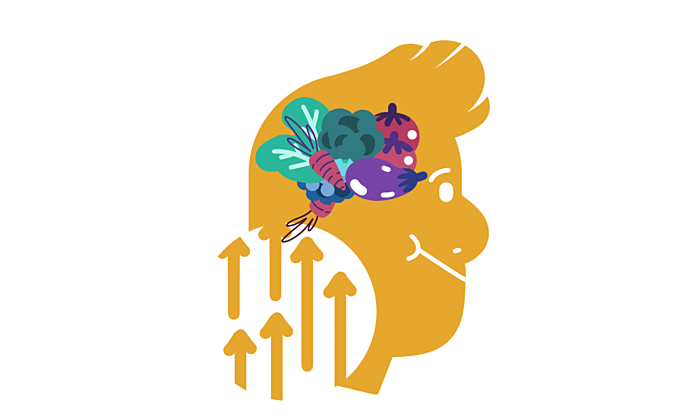
Table of Contents
What are superfoods?
Superfoods are foods that are so rich in nutrients, vitamins, minerals, and antioxidants that they help maintain and improve your health.
They’re mostly plant-based, but researchers believe some fish and dairy products have the same effect.
In general, these foods are a part of a healthy diet that helps improve and maintain various processes in your brain and body.
Top superfoods include blueberries, strawberries, avocado, dark chocolate, bananas, ginger, tomato, spinach, eggplant, water, green tea, red wine, almonds, walnuts, pumpkin seeds, quinoa, oats, salmon, eggs, and yogurt.
Why are superfoods important?
The specific benefits of superfood are various and many, considering that such a healthy, nutritious diet helps:
- reduce the risk of heart disease
- improve memory
- lower cholesterol
- reduce inflammation
- regulate the metabolism
- protect your cells and organs from toxins
Once you’ve triggered these processes in your organism, it’ll be easier for you to focus and maximize productivity – because of this, these foods are also often labeled as brain food.
But, though many foods help with all the listed problems, no single group of foods is labeled as the ultimate superfood.
So, you’ll have to combine various foods in order to get the best effects for your health.
What is the superfood diet?
The top 20 superfoods include fruits, dark chocolate, vegetables, fish, grains, nuts, dairy products, and select drinks – but, not every fruit, vegetable, or grain count as superfoods.
Moreover, not even all superfoods are good for everyone, and overeating on one type of food is never recommended.
Some fruits are high in sugar, making them inappropriate for people with diabetes, and some types of fish (like tuna) are less healthy due to ocean pollution – so, you’ll have to be careful when planning your meals.
Here is a list of superfoods with nutrition facts, and fun, easy-to-make recipes with superfoods that’ll help keep your brain healthy, increase focus, endurance, productivity, memory, and even more than that:
Fruit and healthy sweets
BLUEBERRIES
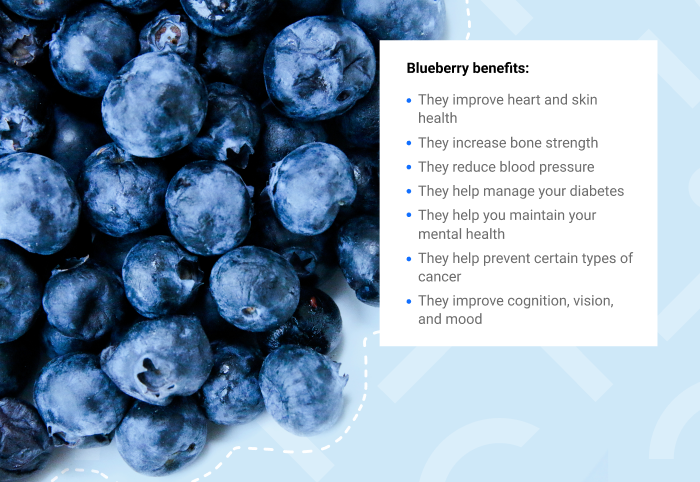
Blueberries are low in calories, rich in nutrients, abundant in vitamin C – and they’re one of the rare foods that are blue in color. They’re also high in antioxidants which means they help regulate and improve a number of processes in the body.
Blueberries are a nice sweet complement to meat and fish, but they’re also great as breakfast smoothies, or when paired with oats, almonds, cinnamon, and brown sugar.
Blueberry benefits:
- They improve heart and skin health
- They increase bone strength
- They reduce blood pressure
- They help manage your diabetes
- They help you maintain your mental health
- They help prevent certain types of cancer
- They improve cognition, vision, and mood (1)
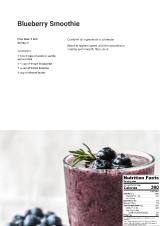 Blueberry Smoothie recipe
Blueberry Smoothie recipe
Prep time: 5 min
Dishes: blender
Serves: 2
Great for: breakfast
🔽 Download Blueberry Smoothie recipe (with nutrition facts)
Source: cookieandkate.com
STRAWBERRIES
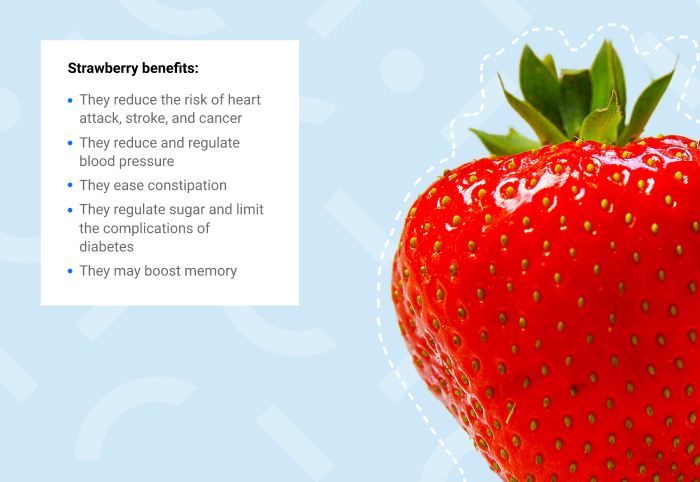
There are over 600 of different varieties of this fruit rich in antioxidants – in Ancient Rome, the Romans believed that strawberries were magical, and the many benefits of this fruit hint at that.
Strawberries have versatile use, and they can be used baked, blended, smashed, in dishes and meals such as shakes, jams, smoothies, cake, salads, or even biscuits. They pair great with other berries, almonds, walnuts, oats, and vanilla.
Strawberry benefits:
- They reduce the risk of heart attack, stroke, and cancer
- They reduce and regulate blood pressure
- They ease constipation
- They regulate sugar and limit the complications of diabetes
- They may boost memory (2)
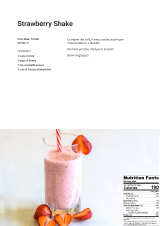 Strawberry Shake recipe
Strawberry Shake recipe
Prep time: 10 mins
Dishes: blender
Serves: 2
Great as: an afternoon snack
🔽 Download Strawberry Shake recipe (with nutrition facts)
Source: allrecipes.com
AVOCADO
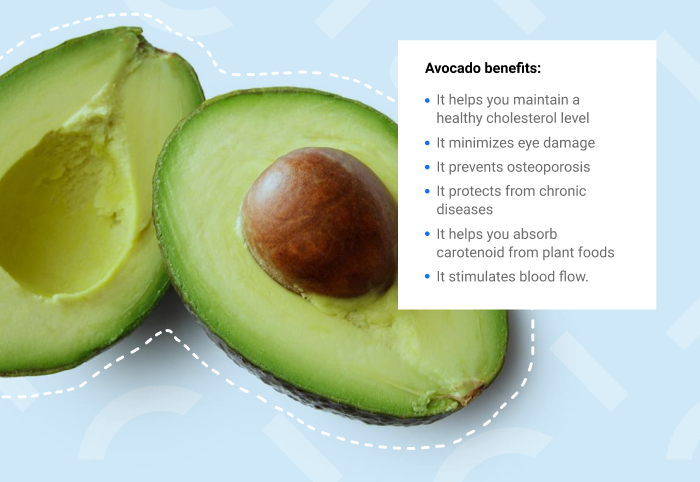
Avocado is often branded as the world’s healthiest fruit – its nutrient-dense structure includes vitamin K, C, E, B-6, niacin, riboflavin, magnesium, beta-carotene, and omega-3 fatty acids.
Avocados are usually buttery and nutty in taste, and there’s plenty of ways to incorporate them in your diet – they’re great when paired with eggs or when added to guacamole, salads, or soups, make a great spread and serve as a healthy substitute to mayo.
Avocado benefits:
- It helps you maintain a healthy cholesterol level
- It minimizes eye damage
- It prevents osteoporosis
- It protects from chronic diseases
- It helps you absorb carotenoid from plant foods
- It stimulates blood flow. (3)
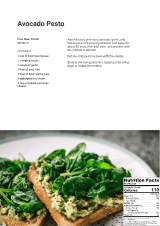 Avocado Pesto recipe
Avocado Pesto recipe
Prep time: 10 min
Dishes: food processor, bowl, mason jar
Serves: 2
Great as a: spread or sauce
🔽 Download Avocado Pesto recipe (with nutrition facts)
Source: ambitiouskitchen.com
DARK CHOCOLATE
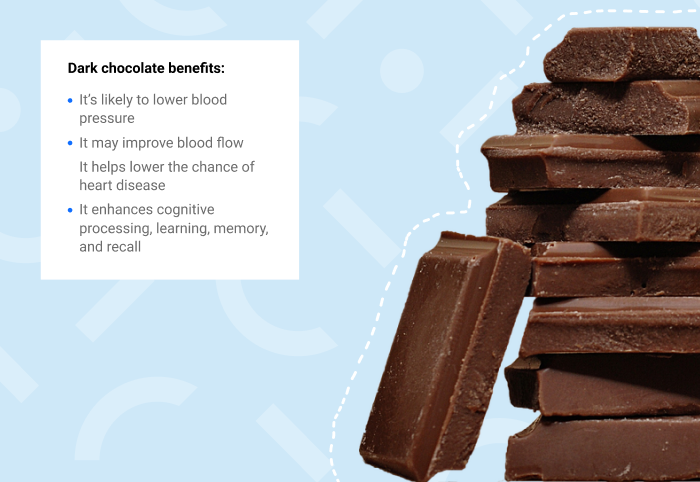
Although the term “chocolate” is often associated with the term “guilty pleasure”, you don’t have to feel guilty over enjoying the occasional bite of dark chocolate – this sweet is rich in antioxidants, manganese, magnesium, and fiber, making it a healthy dessert.
Dark chocolate is high in cocoa, anywhere from 65% to 99% – as the percentage of cocoa rises, the chocolate is less sweet, so keep that in mind when choosing a variety. You can eat it alone, or use it for icings, cookies, glazes, and various sweets.
Dark chocolate benefits:
- It’s likely to lower blood pressure
- It may improve blood flow
- It helps lower the chance of heart disease
- It enhances cognitive processing, learning, memory, and recall (4)
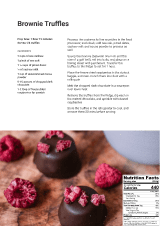 Brownie Truffles recipe
Brownie Truffles recipe
Prep time: 1.25h
Dishes: baking sheet, food processor, rolling pin, saucepan
Makes: 24 truffles
Great as a: quick dessert
🔽 Download Brownie Truffles recipe (with nutrition facts)
Source: spabettie.com
BANANAS

The scientific name for a banana (Musa sapientum) means “fruit of the wise men” – a fitting name for a fruit whose minerals, nutrients, vitamins, and antioxidants have a positive impact on your cognitive processes.
Bananas are another superfood with various uses – you can eat a raw banana for breakfast, or as a snack, use it in desserts, or simply bake simple, yet delicious banana bread.
Banana benefits:
- Its nutrients regulate your blood sugar levels
- It improves digestion
- The potassium and magnesium in bananas may influence heart health
- It may help maintain a healthy kidney function
- The glucose and potassium in bananas help you focus (5)
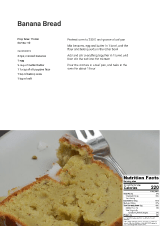 Banana Bread recipe
Banana Bread recipe
Total prep and bake time: 75 min
Dishes: 2 bowls, loaf pan
Serves: 10
Great for: breakfast
🔽 Download Banana Bread recipe (with nutrition facts)
Source: allrecipes.com
Herbs and spices
GINGER
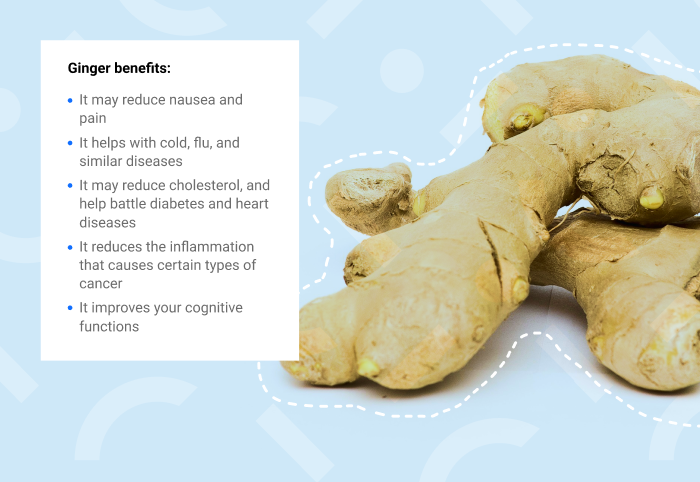
Ginger really is a superfood among spices and herbs – considering that its plant can grow up to be 4 ft. tall. But, it’s size isn’t the most important factor that makes ginger stand out as a superfood – this plant is also rich in hundreds of healthy metabolites and compounds.
Ginger is great as a spice – light, tangy and sweet, it can be used to enhance a variety of dishes both sweet and savory. Specifically, it’s great in sauces, paired with maple syrup, or used in glazes for meat and vegetables.
Ginger benefits:
- It may reduce nausea and pain
- It helps with cold, flu, and similar diseases
- It may reduce cholesterol, and help battle diabetes and heart diseases
- It reduces the inflammation that causes certain types of cancer
- It improves your cognitive functions (6)
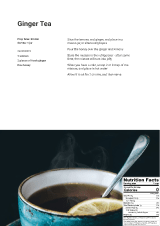 Ginger remedy for cold tea recipe ☕
Ginger remedy for cold tea recipe ☕
Prep time: 20 min
Dishes: mason jar
Makes: 1 jar
Great as: a remedy for cold
🔽 Download Ginger Tea recipe (with nutrition facts)
Source: simplegreensmoothies.com
Fruits/Vegetables
TOMATO
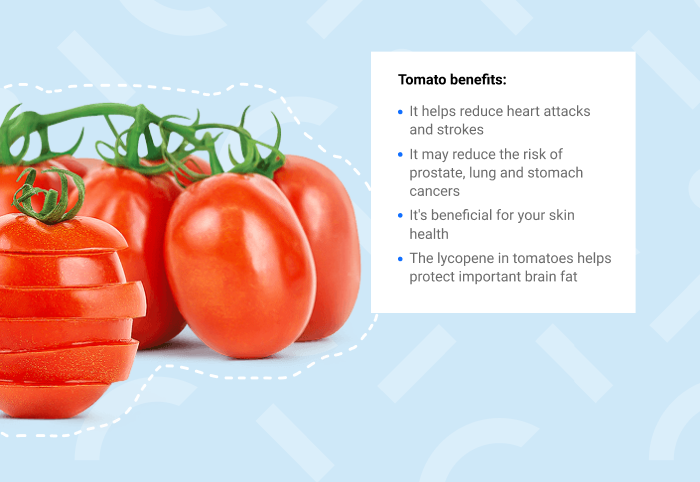
Tomato often causes confusion when it comes to its classification – scientifically speaking, it’s a fruit, yet, it’s often used as a vegetable in cooking. But, there’s no confusion on whether the tomato is a superfood – this fruit/vegetable is 95% water, with a healthy amount of fiber, vitamin C, folate, lycopene, and beta-carotene.
Tomato is another versatile superfood, and there are several tomato varieties – beefsteak tomatoes are great in sandwiches, plum tomatoes are ideal for sauces, cherry tomatoes are perfect for salads, and heirloom tomatoes are best used raw.
Tomato benefits:
- It helps reduce heart attacks and strokes
- It may reduce the risk of prostate, lung, and stomach cancers
- It’s beneficial for your skin’s health
- The lycopene in tomatoes helps protect important brain fat (7)
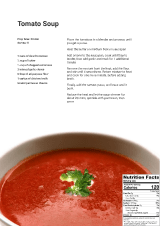 Tomato Soup recipe
Tomato Soup recipe
Prep time: 30 min
Dishes: blender and saucepan
Serves: 8
Great as an: appetizer
🔽 Download Tomato Soup recipe (with nutrition facts)
Source: tasteofhome.com
EGGPLANT
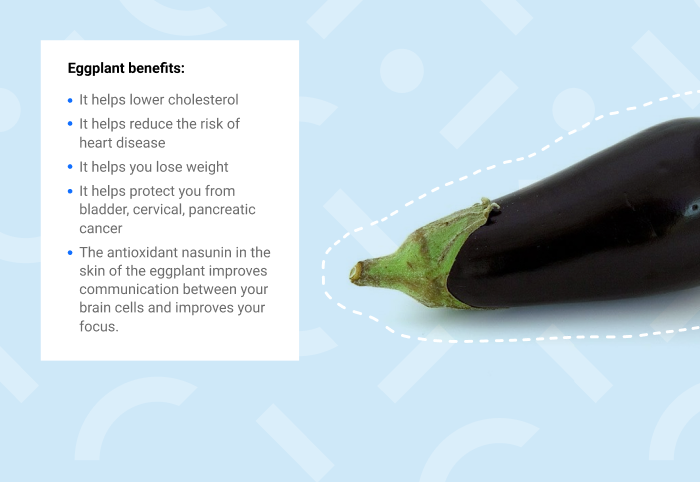
The eggplant is another plant with an ambiguous classification – it’s often used as a vegetable in cooking, but it’s technically a berry. You shouldn’t eat an eggplant raw, but, you also shouldn’t peel off its skin before cooking – the skin has a lot of nutritious benefits, just as the rest of this fruit/vegetable.
Eggplants are best grilled, roasted, used in curries, stews, and soups – specifically, they’re used in many Greek, Middle Eastern, and Italien dishes. In order to keep them low in calories and fat, it’s best to cook them in wine or vegetable juice.
Eggplant benefits:
- It helps lower cholesterol
- It helps reduce the risk of heart disease
- It helps you lose weight
- It helps protect you from bladder, cervical, pancreatic cancer
- The antioxidant nasunin in the skin of the eggplant improves communication between your brain cells and improves your focus. (9)
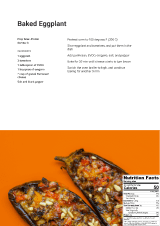 Baked Eggplant recipe
Baked Eggplant recipe
Total prep and bake time: 45 min
Dishes: non-stick baking dish
Serves: 6
Great for: lunch
🔽 Download Baked Eggplant recipe (with nutrition facts)
Source: allrecepies.com
Vegetables
SPINACH

During the Depression era in the 1930s, the U.S government was looking for a way to encourage the nation to eat spinach, as an iron-rich alternative to meat. So, they greenlit Popeye, a cartoon about a sailor who gains superhuman strength when he eats spinach – and this vegetable’s real-life benefits nicely complement fiction.
Spinach can be used cooked, sauteed, or fresh – it’s a nice complement to kinds of pasta, soups, and stews, it goes great with eggs, and it works nicely in sandwiches, wraps, and enchiladas.
Spinach benefits:
- The chlorophyll in spinach helps prevent cancer
- The beta-carotene helps prevent asthma
- The high level of potassium helps lower blood pressure
- The Vitamin K helps maintain bone health
- It slows down cognitive decline
- It improves motor skills and learning capacity (8)
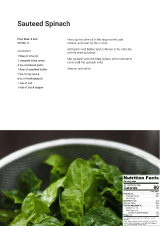 Sauteed Spinach recipe
Sauteed Spinach recipe
Prep time: 9 min
Dishes: large skillet
Serves: 4
Great as a: side dish
🔽 Download Sauteed Spinach recipe (with nutrition facts)
Source: crunchycreamysweet.com
Drinks
WATER

Water technically isn’t “food”, but it’s more “super” than any of the entries in this list – you can live your entire life without ever tasting blueberries or avocado, but you can only last for a week without water.
In order to maintain a healthy amount of water in your body, you should drink when you’re thirsty, but also drink more water after exercising, in order to compensate for the lost fluids. If you get tired of regular water, you can try a variety of waters infused with fruit and spices.
Water benefits:
- It delivers oxygen through the body
- It helps regulate body temperature and helps you tolerate heat
- It eases asthma and allergies
- It helps prevent kidney damage
- It dissolves vitamins and minerals in food and helps your body absorb them
- It helps maintain a healthy brain structure and functions
- It hydrates you and expands your brain’s gray matter, resulting in a 14% increase in productivity (10)
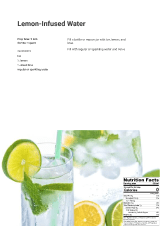 Lemon-Infused Water recipe
Lemon-Infused Water recipe
Prep time: 5 min
Dishes: bottle or mason jar
Makes: 1 quart
Great as: an everyday drink
🔽 Download Lemon Infused Water recipe (with nutrition facts)
Source: wholefully.com
GREEN TEA
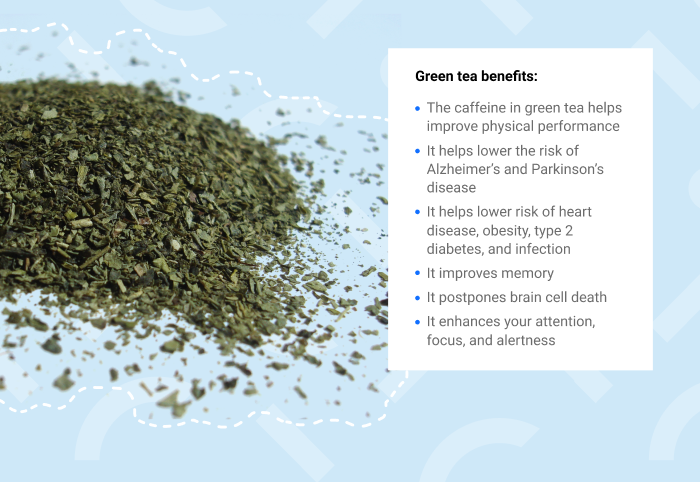
Green tea is the least processed type of tea – this, and the fact that it’s filled with antioxidants, minerals, and amino-acids explains why green tea is often lauded as the most popular drink in the world, right after water.
Green tea works best when you drink it between meals, before exercising, or at least two hours before bedtime (otherwise the caffeine might keep you awake) – and there are 7 varieties of green tea you can try.
Green tea benefits:
- The caffeine in green tea helps improve physical performance
- It helps lower the risk of Alzheimer’s and Parkinson’s disease
- It helps lower risk of heart disease, obesity, type 2 diabetes, and infection
- It improves memory
- It postpones brain cell death
- It enhances your attention, focus, and alertness (11)
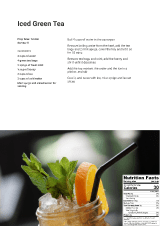 Iced Green tea recipe
Iced Green tea recipe
Prep time: 12 min
Dishes: saucepan and pitcher
Serves: 8
Great as: an afternoon drink
🔽 Download Iced Green tea recipe (with nutrition facts)
Source: thechunkychef.com
RED WINE
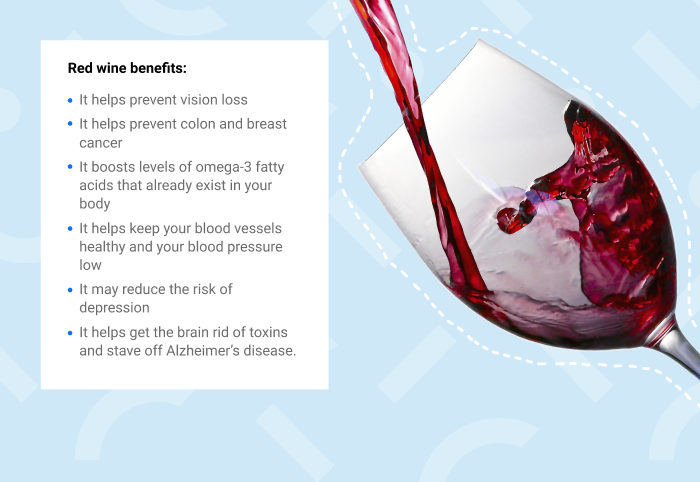
Drinking alcohol is often linked with various drawbacks – but, perhaps surprisingly, studies show that drinking red wine in moderate doses is healthier than not drinking at all.
As you’d expect, you can drink red wine, but you can also cook and bake with it, to bring out the flavor of your meals – use it in mussels, when preparing steak, when cooking with onions, or when making a strawberry dessert. Mulled wine may be the standout red wine recipe – it’s a popular winter treat, and it’s easy to make.
Red wine benefits:
- It helps prevent vision loss
- It helps prevent colon and breast cancer
- It boosts levels of omega-3 fatty acids that already exist in your body
- It helps keep your blood vessels healthy and your blood pressure low
- It may reduce the risk of depression
- It helps get the brain rid of toxins and stave off Alzheimer’s disease. (12)
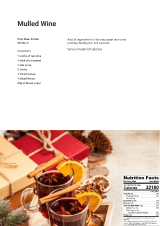 Mulled Wine recipe
Mulled Wine recipe
Prep time: 40 min
Dishes: saucepan
Serves: 2
Great as: an afternoon drink
🔽 Download Mulled Wine recipe (with nutrition facts)
Source: bbc.com
Nuts and seeds
ALMONDS
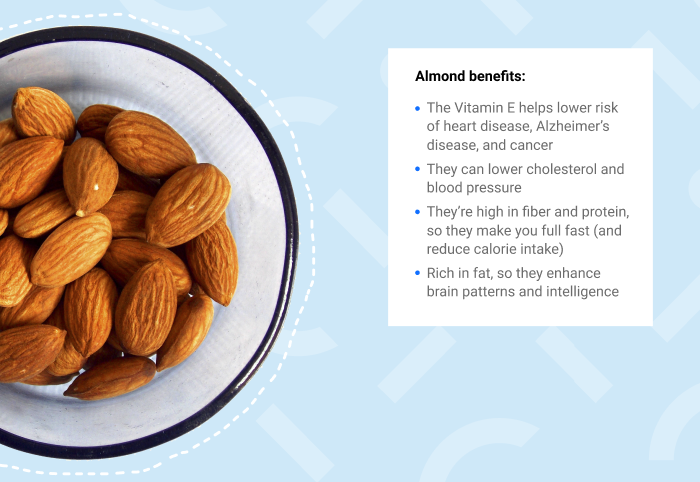
The almond tree doesn’t bear fruit during the first 3-4 years – but, when it does, you can enjoy an excellent source of vitamin B, vitamin E, calcium, magnesium, and niacin.
You can eat almonds whole, as snacks, but you can also incorporate them in various dishes – highlights include smoothies, toppings, soups, sauces, and savory dishes such as fruit salads. They’re paired off great with rice, quinoa, and various cooked vegetables – but they’re also nice on their own, in the form of homemade almond butter.
Almond benefits:
- The Vitamin E helps lower risk of heart disease, Alzheimer’s disease, and cancer
- They can lower cholesterol and blood pressure
- They’re high in fiber and protein, so they make you full fast (and reduce calorie intake)
- Rich in fat, so they enhance brain patterns and intelligence (13)
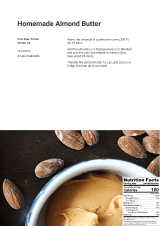 Homemade Almond Butter recipe
Homemade Almond Butter recipe
Prep time: 30 min
Dishes: food processor or blender
Serves: 24
Great as: a side dish or topping
🔽 Download Homemade Almond Butter recipe (with nutrition facts)
Source: detoxinista.com
WALNUTS
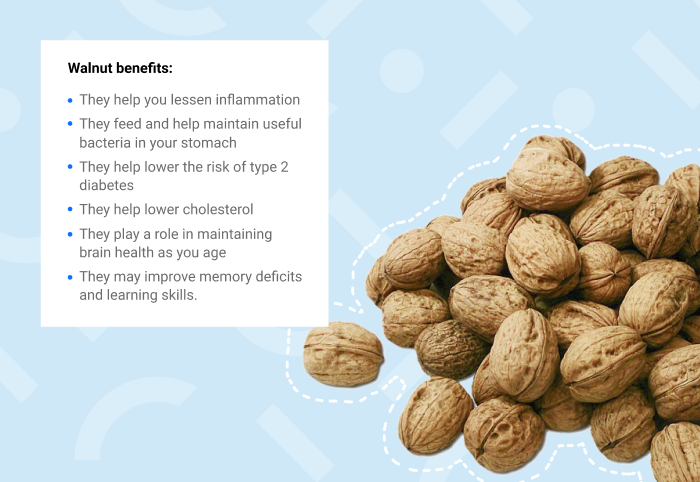
Walnuts are the oldest tree that bears food known to man, and they were often praised by the Ancient Romans and Greeks – today, their reputation still stands, as they represent the biggest omega-3 fatty acids source among nuts, among other benefits.
Walnuts are a great healthy option for a snack on their own, either raw or toasted. But, they’re also great when paired up with sweet potatoes (for lunch or dinner), pears or rosemary (for dessert). Apart from that, you can also make walnut pesto or walnut bread.
Walnut benefits:
- They help you lessen inflammation
- They feed and help maintain useful bacteria in your stomach
- They help lower the risk of type 2 diabetes
- They help lower cholesterol
- They play a role in maintaining brain health as you age
- They may improve memory deficits and learning skills. (14)
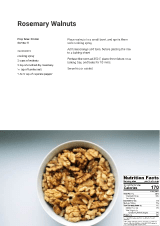 Rosemary Walnuts recipe
Rosemary Walnuts recipe
Prep time: 20 min
Dishes: small bowl and baking tray
Makes: 2 cups
Great as: a snack
🔽 Download rosemary walnuts recipe (with nutrition facts)
Source: tasteofhome.com
PUMPKIN SEEDS
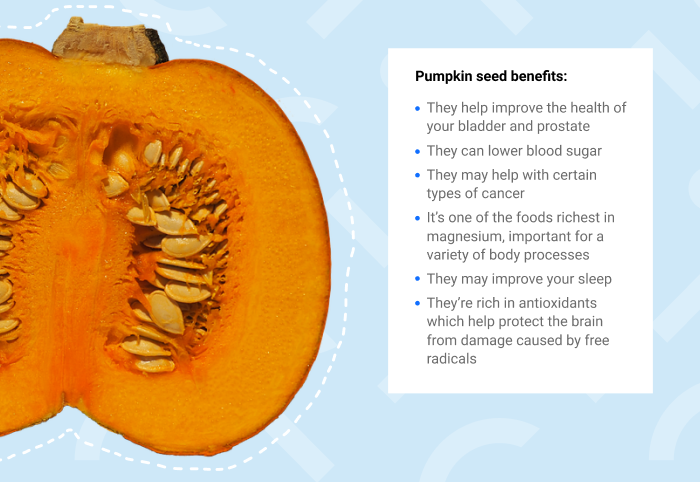
Each pumpkin contains about 500 pumpkin seeds – raw or roasted, they offer a number of minerals and vitamins, including calcium, vitamin B, beta-carotene, calcium, and selenium.
Pumpkin seeds have a number of uses, which may explain why they’re so popular – you can use them in salads, smoothies, pesto, soup, or cookies. For extra flair in your everyday dishes, you can make pumpkin seed butter, and add pumpkin seeds to homemade bread.
Pumpkin seed benefits:
- They help improve the health of your bladder and prostate
- They can lower blood sugar
- They may help with certain types of cancer
- It’s one of the foods richest in magnesium, important for a variety of body processes
- They may improve your sleep
- They’re rich in antioxidants which help protect the brain from damage caused by free radicals (16)
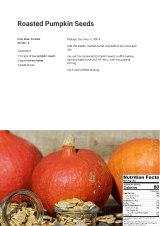 Roasted Pumpkin Seeds recipe
Roasted Pumpkin Seeds recipe
Total prep and roast time: 50 mins
Dishes: bowl and baking tray
Serves: 6
Great as: a snack
🔽 Download Roasted Pumpkin Seeds recipe (with nutrition facts)
Source: allrecipes.com
QUINOA
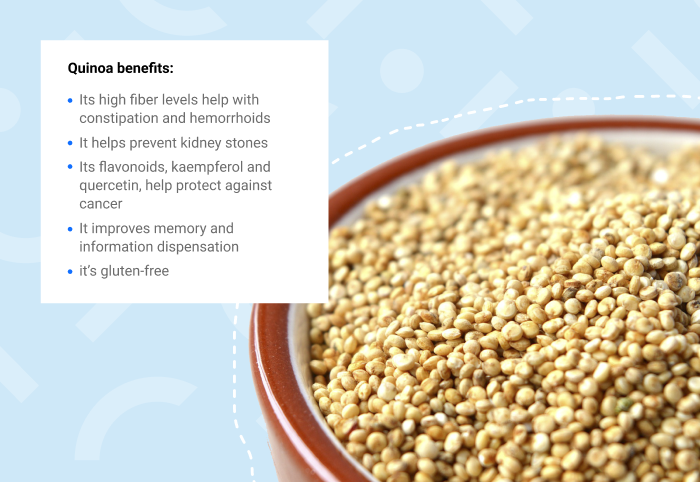
Quinoa is one of the most durable seeds, making it a reliable food source – it can survive in drought, freezing temperatures, or even poor soil conditions. It’s rich in complex carbohydrates, Omega 3 fatty acids, fiber, lysine, but it’s also a full protein – it contains all 9 amino acids.
You can easily incorporate quinoa to your breakfast, lunch, or dinner – they’re an effective addition to salads, breakfast porridge, burger patties, soups, stews, or various desserts.
Quinoa benefits:
- Its high fiber levels help with constipation and hemorrhoids
- It helps prevent kidney stones
- Its flavonoids, kaempferol and quercetin, help protect against cancer
- It improves memory and information dispensation
- it’s gluten-free (17)
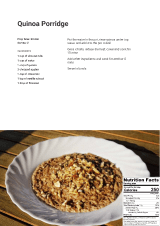 Quinoa Porridge recipe
Quinoa Porridge recipe
Total prep and cooking time: 20 mins
Dishes: pot
Serves: 2
Great for: dinner
🔽 Download Quinoa Porridge recipe (with nutrition facts)
Source: thehealthychef.com
Cereals
OATS
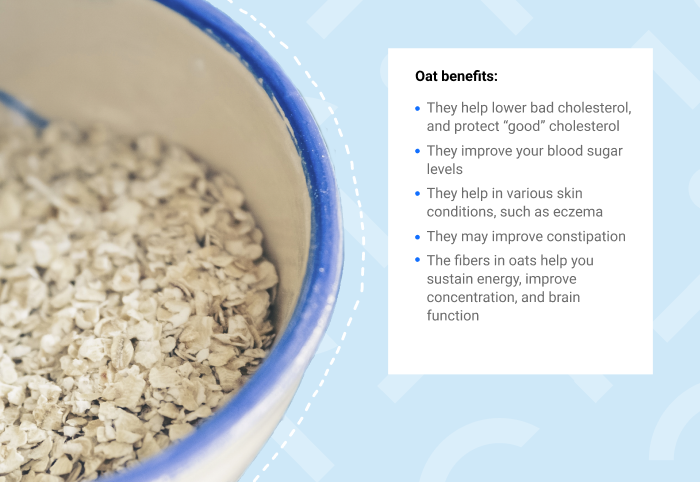
About 95% of all oats are used as food for livestock – but the 5% of this whole-grain food used by humans offer a rich palette of minerals and vitamins, including manganese, zinc, and Vitamin B.
Oats have a long tradition of being used for breakfast oatmeal – but you can also use them in cookies, pies, risottos, muffins, homemade granola bars, parfaits, and various other types of dishes.
Oats benefits:
- They help bad lower cholesterol, and protect “good” cholesterol
- They improve your blood sugar levels
- They help in various skin conditions, such as eczema
- They may improve constipation
- The fibers in oats help you sustain energy, improve concentration, and brain function (18)
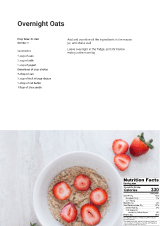 Overnight Oats recipe
Overnight Oats recipe
Total prep and cooling time: 5+ mins
Dishes: mason jar
Serves: 1
Great as: a quick breakfast
🔽 Download overnight oats recipe (with nutrition facts)
Source: chocolatecoveredkatie.com
Fish and dairy products
SALMON

Salmon is a widely popular food choice – it attracts various birds, whales, dolphins, seals, but also humans. Actually, this nutritious fish is our perfect brain food considering that the human brain is 60% fat, and that salmon is high in omega-3 fatty acids.
There’s plenty of ways to prepare salmon – you can roast it in the oven, fry it in a pan, broil it, grill it, cook it, or poach it. This fish pairs up well broccoli, lemon, asparagus, potatoes, carrots, and quinoa.
Salmon benefits:
- Its high level of protein helps maintain muscle mass and ease the aging process
- The potassium in salmon helps reduce the risk of stroke
- The selenium in salmon helps protect your bone health
- It’s an excellent brain food that improves mental performance and memory (19)
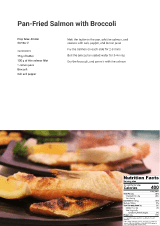 Pan-fried Salmon With Broccoli
Pan-fried Salmon With Broccoli
Total prep and frying time: 40 mins
Dishes: frying pan
Serves: 2
Great for: lunch
🔽 Download Pan-fried Salmon With Broccoli recipe (with nutrition facts)
Source: bbc.com
EGGS

The ancient “egg or chicken” riddle was recently solved – it was the egg that came first and not the chicken. Such an answer more than hints at the importance of eggs – this animal product is rich in folate, pantothenic acid, selenium, and iodine, among other vitamins and minerals.
Eggs probably hold the title of the most versatile superfood, as you can cook them in many ways, pair them up with many foods, and use them in many types of dishes. Specifically, you can make boiled and scrambled eggs, use them in omelets and frittatas, pair them with various vegetables, and use them for lunches, dinners, breakfasts, snacks, and desserts.
Eggs benefits:
- They help raise “good” cholesterol
- The antioxidants lutein and zeaxanthin in eggs improve your eye health
- They help lower triglycerides
- High in choline, a micronutrient that helps improve memory and mental function (20)
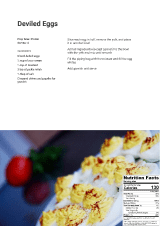 Deviled eggs recipe (without mayo)
Deviled eggs recipe (without mayo)
Prep time: 35 mins
Dishes: 2 bowls, piping bag
Serves: 4
Great for: dinner
🔽 Download Deviled Eggs recipe (with nutrition facts)
Source: foodal.com
YOGURT
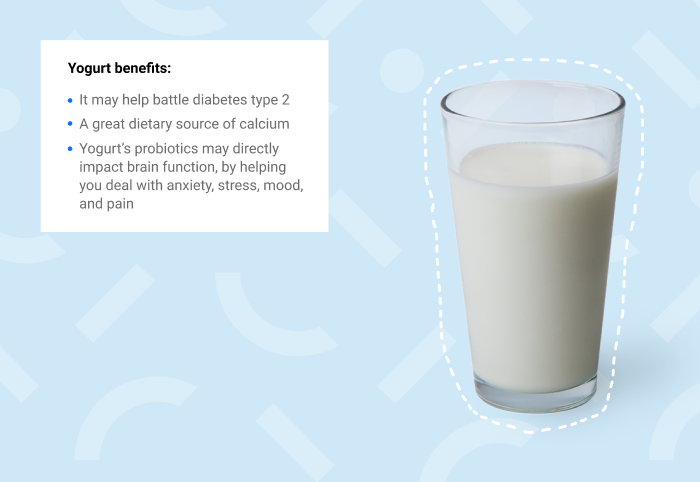
Americans alone consume over 300,000 tonnes of yogurt per year, and this dairy product earns the trust – it’s high in nutrients, calcium, potassium, Vitamin B12, and Riboflavin.
Just like with eggs, you can add yogurt to almost anything – it’s a subtle addition to salad dressings and marinades, it nicely complements roasted vegetables, it lends creaminess to soups, and serves as another healthy alternative to mayo.
Yogurt benefits:
- It may help battle diabetes type 2
- A great dietary source of calcium
- Yogurt’s probiotics may directly impact brain function, by helping you deal with anxiety, stress, mood, and pain (22)
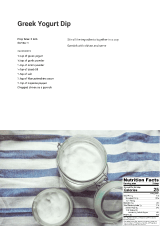 Greek yogurt dip
Greek yogurt dip
Prep time: 3 mins
Dishes: cup
Makes: 1 cup
Great as a: side dish
🔽 Download Greek Yogurt Dip recipe (with nutrition facts)
Source: wellplated.com
💡Clockify pro tip
If you want to be more productive, improving your nutrition with these superfoods is just one of the options. Take a look at these 25 tips you can implement today to increase your productivity.
You can also make a free Clockify account and learn just how you spend your work and free time and see if there is room for improvement.
Blueberries
- The Acute Effects of Low and High doses of Blueberry Flavonoids on Vision, Cognition, and Mood
- Blueberries May Improve Attention In Children Following Double-blind Trial
- 11 Ways to Use Blueberries
Strawberries
- A Natural Chemical Found In Strawberries Boosts Memory In Healthy Mice
- Fisetin Lowers Methylglyoxal Dependent Protein Glycation and Limits the Complications of Diabetes
- Strawberry History, Folklore, Myth and Magic
- A Flavor Guide to Pairing Fruits in Drinks
Avocado
- Carotenoid Absorption from Salad and Salsa by Humans Is Enhanced by the Addition of Avocado or Avocado Oil
- Health benefits of dietary fiber
Dark chocolate
- Dark chocolate (70% organic cacao) increases acute and chronic EEG power spectral
- Different Types of Chocolate and How to Use Them for Baking
Bananas
Ginger
- Zingiber officinale Improves Cognitive Function of the Middle-Aged Healthy Women
- The Amazing and Mighty Ginger
- Cooking with Fresh Ginger
- Cooking With Spices: Ginger
Tomato
- An Update on the Health Effects of Tomato Lycopene
- Tomatoes, tomato-based products, lycopene, and cancer: review of the epidemiologic literature
- A review of epidemiologic studies of tomatoes, lycopene, and prostate cancer
- Supplementation with tomato-based products increases lycopene, phytofluene, and phytoene levels
- The Best Uses for Different Varieties of Tomatoes
Spinach
- Chopped, uncooked spinach offers more antioxidants
- Popeye and the Great Spinach Myth
- Cancer chemoprevention by dietary chlorophylls: A 12,000-animal dose-dose matrix biomarker and tumor study
- Serum vitamin A and beta-carotene levels in children with asthma
Eggplant
- Antioxidant activity of nasunin, an anthocyanin in eggplant peels
- Eight Fascinating Facts About Eggplant
- The Many Uses of Eggplant
Water
- New Study Shows Drinking Water Can Increase Productivity by 14 Percent
- How long a person can survive without water
Green Tea
- The Science Behind Why Japanese Green Tea can Make You Smarter
- Effects of l-theanine on attention and reaction time response
- 30 Scientific and Incredible Facts about Green Tea
- Effects of caffeine ingestion on exercise testing: a meta-analysis
- Neurological mechanisms of green tea polyphenols in Alzheimer’s and Parkinson’s diseases
- 4 Best Times to Drink Green Tea
- 7 Varieties of Green Tea, Explained
Red Wine
- Resveratrol Attenuates Trimethylamine-N-Oxide (TMAO)-Induced Atherosclerosis by Regulating TMAO Synthesis and Bile Acid Metabolism
- 12 Fascinating Facts About Red Wine
- Red grape chemical may help prevent bowel cancer but less is more
- Alcohol intake, wine consumption and the development of depression
- Cooking with Wine
Almonds
- Reduced risk of colon cancer with high intake of vitamin E: the Iowa Women’s Health Study
- A controlled trial of selegiline, alpha-tocopherol, or both as treatment for Alzheimer’s disease
- Nutritional status, brain network organization, and general intelligence
- Vitamin E consumption and the risk of coronary disease in women
Walnuts
- Dietary supplementation of walnuts improves memory deficits and learning skills in transgenic mouse model of Alzheimer’s disease
- Role of walnuts in maintaining brain health with age
- Long-term associations of nut consumption with body weight and obesity
- Surprising Facts About Walnuts
- 5 Delicious Ways to Serve Walnuts
Pumpkin seeds
- Characteristics of antioxidant activity and composition of pumpkin seed oils in 12 cultivars
- Pumpkin Seed Oil Extracted From Cucurbita maxima Improves Urinary Disorder in Human Overactive Bladder
- How Many Seeds in a Pumpkin
- 10 Awesome Ways to Use Pumpkin Seeds
Quinoa
- Nutritional value- International Year of Quinoa 2013
- A review of the dietary flavonoid, kaempferol on human health and cancer chemoprevention”
- 10 Fun Facts about Quinoa/
- 8 Ways To Eat Quinoa For Breakfast, Lunch And Dinner
Oats
- Why Every Athlete Needs Oats
- Anti-inflammatory activities of colloidal oatmeal (Avena sativa) contribute to the effectiveness of oats in treatment of itch
- Oatmeal Fun Facts
- 13 Oat Recipes That Aren’t Breakfast Oatmeal
Salmon
- Essential fatty acids and human brain
- Role of dietary protein in the sarcopenia of aging
- Selenium in bone health: roles in antioxidant protection and cell proliferation
- Protein and healthy aging
- Potassium intake and risk of stroke in women with hypertension and nonhypertension in the Women’s Health Initiative
- Interesting facts about salmon
- How to Cook Salmon Seven Ways
Eggs
- Eggcyclopedia:Choline
- Identification of lutein and zeaxanthin oxidation products in human and monkey retinas
- The Egg Makes Its Move In A New Version Of Which Came First: The Chicken Or the Egg
Yogurt
- Yogurt’s Brainy Effects
- Dairy consumption and risk of type 2 diabetes: 3 cohorts of US adults and an updated meta-analysis
- Randomized Open-Label Pilot Study of the Influence of Probiotics and the Gut Microbiome on Toxic Metal Levels
- Yogurt Fun Facts
- 8 Ways to Use Yogurt in Your Cooking (i.e., Put It in Everything)





